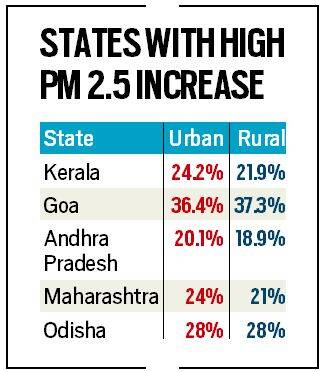Trends in Air Pollution: CPCB | 27 Nov 2020
Why in News
According to a recent study commissioned by the Central Pollution Control Board (CPCB), the rate of increase in pollution levels in southern and eastern India is far greater than the Indo-Gangetic plain (IGP).
- It has also found that air pollution in rural areas has increased at par with urban India.
Key Points
- About the Study:
- It was jointly carried out by IIT-Delhi and CPCB and analysed data from 2000 to 2019.
- Currently, the process of collating and analysing the 2020 data is going on as well and a decrease in pollution levels is expected in the coming years.
- The study, conducted on the basis of satellite data, is the first of its kind to look at air pollution spatially.
- Spatial mapping of pollution will be vital for the government to form its future policies under the National Clean Air Programme (NCAP).
- It was jointly carried out by IIT-Delhi and CPCB and analysed data from 2000 to 2019.
- Findings:
- The rate of increase of PM2.5 over eastern and southern India is more than 1.6% per year during this period, and less than 1.2% annually in the IGP.
- PM2.5 are fine inhalable particles, with diameters that are generally 2.5 micrometers and smaller.
- It is a major pollutant affecting the environment, human health and the climate.
- 436 cities/towns with a population of more than 1 lakh in 2019 exceeded the National Ambient Air Quality Standard (NAAQS) of 40 micrograms per metric cube (μg/m3).
- Population-weighted 20-year averaged PM2.5 over India is 57.3 μg/m3, with a larger increase observed between 2010 and 2019 than in the 2000-09 period.
- As of 2019, 99.5% of districts in India did not meet the World Health Organisation (WHO) air quality guideline of 10 μg/m3.
- Statewise Data:
- Ambient PM2.5 exceeds the annual NAAQS of 40 μg/m3 in every state except for Jammu and Kashmir (J&K), Ladakh, Himachal Pradesh, Sikkim, Arunachal Pradesh, Manipur and Nagaland.
- The PM2.5 level in the IGP, which has a population of more than 70 crore, and the western arid region is more than double the annual NAAQS.

- In Odisha and Chhattisgarh, which have reported among the highest increase in air pollution in eastern India, this is due to mining activities and thermal coal power plants.
- In southern India, high urbanisation in and around cities such as Bengaluru or Hyderabad has led to increased emissions.
- Unfavourable meteorological conditions in eastern and peninsular India, along with increase in emissions, has led to an overall increase in PM 2.5.
- Analysis:
- While in absolute terms the level of air pollution continues to be the highest in the IGP, the rate of increase in air pollution is much higher in southern India and certain areas of eastern India.
- If the focus continues to be on IGP and the increasing pollution (levels) in southern and eastern India is not addressed now, in another 10 years these regions will also have the same problem as northern India does.
- The rate of increase of PM2.5 over eastern and southern India is more than 1.6% per year during this period, and less than 1.2% annually in the IGP.
- Urban-rural Divide:
- On PM2.5 levels cutting across the urban-rural divide, the study cites the example of Delhi, where it increased by 10.9% between 2001 to 2015.
- During the same period, PM2.5 exposure in rural India rose by 11.9%.
- A steady air pollution rise in rural India is due to high reliance on solid fuel for domestic use, which is the largest contributor to ambient PM2.5 in India.
- This implies that poor air quality in India is not an urban-centric problem.
- Air pollution in rural areas is rarely discussed with air pollution policies which continue to focus on urban centres.
- Schemes like the Pradhan Mantri Ujjwala Yojana (PMUY) are expected to decrease the pollution levels but it lacks a mechanism to track its progress.
- Since the household sources contribute more than 50% to ambient PM2.5 in rural areas, successful implementation of PMUY with sustained usage should arrest or even reverse the increasing trend in rural PM2.5.
- On PM2.5 levels cutting across the urban-rural divide, the study cites the example of Delhi, where it increased by 10.9% between 2001 to 2015.
